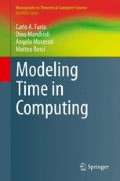Abstract
In this chapter, we present the fundamental abstractions used to model digital circuits, from the level of networks of transistors, to logic gates, sequential machines, up to synchronous state machines and dataflow modular abstractions. The presentation devotes particular attention to how the representation of time changes with the increased abstraction of the various models, along the dimensions introduced in Chap. 3. For example, we discuss how the time domain shifts from continuous to discrete, the coordination of signals increases the level of synchrony, and the representation of time, initially explicit, becomes implicit.
Access this chapter
Tax calculation will be finalised at checkout
Purchases are for personal use only
Notes
- 1.
Under the assumption that the forbidden input \(S = R = 0\) never occurs.
References
Abarbanel-Vinov, Y., Aizenbud-Reshef, N., Beer, I., Eisner, C., Geist, D., Heyman, T., Reuveni, I., Rippel, E., Shitsevalov, I., Wolfsthal, Y., Yatzkar-Haham, T.: On the effective deployment of functional formal verification. Form. Method Syst. Des. 19, 35–44 (2001)
Agarwal, A., Lang, J.: Foundations of Analog and Digital Electronic Circuits. Morgan Kaufmann, Amsterdam (2005)
Baylis, J.: Error Correcting Codes: A Mathematical Introduction. Chapman and Hall, London/New York (1997)
Booth, T.L.: Sequential Machines and Automata Theory. Wiley, New York (1967)
DeMassa, T.A., Ciccone, Z.: Digital Integrated Circuits. Wiley (2008)
Fix, L.: Fifteen years of formal property verification in Intel. In: Grumberg, O., Veith, H. (eds.) 25 Years of Model Checking-History, Achievements, Perspectives. Lecture Notes in Computer Science, vol. 5000, pp. 139–144. Springer, Berlin (2008)
Gill, A.: Introduction to the Theory of Finite-State Machines. McGraw-Hill, New York (1962)
Ginsburg, S.: Introduction to Mathematical Machine Theory. Addison-Wesley, Reading (1982)
Grumberg, O., Veith, H. (eds.): 25 Years of Model Checking—History, Achievements, Perspectives. Lecture Notes in Computer Science, vol. 5000. Springer, Berlin (2008)
Heuring, V.P., Jordan, H.F.: Computer Systems Design and Architecture, 2nd edn. Prentice Hall, Harlow (2003)
Hickman, I.: Analog Electronics, 2nd edn. Newnes, Oxford/Boston (1999)
Hodges, D., Jackson, H., Saleh, R.: Analysis and Design of Digital Integrated Circuits. McGraw-Hill, Boston (2003)
Hopcroft, J.E., Motwani, R., Ullman, J.D.: Introduction to Automata Theory, Languages, and Computation, 3rd edn. Addison-Wesley, Boston (2006)
Jansen, D.: The Electronic Design Automation Handbook. Springer, Dordrecht (2003)
Jansen, D.: Electronic Design Automation for Integrated Circuits Handbook. CRC, Boca Raton (2006)
Kam, T., Villa, T., Brayton, R.K., Sangiovanni-Vincentelli, A.L.: Synthesis of Finite State Machines: Logic Optimization. Springer, Boston (1997)
Kam, T., Villa, T., Brayton, R.K., Sangiovanni-Vincentelli, A.L.: Synthesis of Finite State Machines: Functional Optimization. Springer, Boston (1997)
Katz, R.H., Borriello, G.: Contemporary Logic Design, 2nd edn. Prentice Hall, Upper Saddle River (2004)
Kohavi, Z.: Switching and Finite Automata Theory, 2nd edn. McGraw-Hill, New York (1978)
Kurshan, R.P.: Verification technology transfer. In: Grumberg, O., Veith, H. (eds.) 25 Years of Model Checking-History, Achievements, Perspectives. Lecture Notes in Computer Science, vol. 5000, pp. 46–64. Springer, Berlin (2008)
MacWilliams, F.J., Sloane, N.J.A.: The Theory of Error-Correcting Codes. North Holland, Amsterdam (1998)
Mandrioli, D., Ghezzi, C.: Theoretical Foundations of Computer Sciences. Wiley, New York (1987)
Martin, K.: Digital Integrated Circuit Design. Oxford University Press, New York (1999)
Mealy, G.H.: A method for synthesizing sequential circuits. Bell Syst. Tech. J. 34, 1045–1079 (1955)
Minsky, M.L.: Computation: Finite and Infinite Machines. Prentice Hall, Englewood Cliffs (1967)
Moore, E.F.: Gedanken-experiments on sequential machines. In: Automata Studies. Annals of Mathematical Studies, vol. 34, pp. 129–153. Princeton University Press, Princeton (1956)
Nagel, L.W.: Spice2: a computer program to simulate semiconductor circuits. Ph.D. thesis, EECS Department, University of California, Berkeley (1975)
Nagel, L.W., Pederson, D.: SPICE (simulation program with integrated circuit emphasis). Tech. Rep. UCB/ERL M382, EECS Department, University of California, Berkeley (1973)
von Neumann, J.: Probabilistic logics and the synthesis of reliable organisms from unreliable components. In: Automata Studies, pp. 329–378. Princeton University Press, Princeton (1956)
Patterson, D.A., Hennessy, J.L.: Computer Organization and Design, 4th edn. Morgan Kaufmann, Burlington (2008)
Quarles, T.L.: Analysis of performance and convergence issues for circuit simulation. Ph.D. thesis, EECS Department, University of California, Berkeley (1989)
Rabaey, J.M., Chandrakasan, A., Nikolic, B.: Digital Integrated Circuits, 2nd edn. Prentice Hall, Upper Saddle River (2003)
Rubin, S.M.: Computer Aids for VLSI Design. Addison-Wesley, Reading (1987). Available online at http://www.rulabinsky.com/cavd/
Sipser, M.: Introduction to the Theory of Computation, 2nd edn. Course Technology, Boston (2005)
SPICE: Simulation program with integrated circuit emphasis. http://bwrc.eecs.berkeley.edu/Classes/IcBook/SPICE/
Stroustrup, B.: The C++ Programming Language, 3rd edn. Addison-Wesley, Boston (2000)
The open SystemC initiative. http://www.systemc.org
Tanenbaum, A.S.: Structured Computer Organization, 5th edn. Prentice Hall, Upper Saddle River (2005)
Thomas, D.E., Moorby, P.R.: The Verilog Hardware Description Language, 5th edn. Springer, New York (2002)
Tocci, R.J., Widmer, N., Moss, G.: Digital Systems: Principles and Applications, 11th edn. Prentice Hall, Harlow (2010)
Vardi, M.Y.: From church and prior to PSL. In: Grumberg, O., Veith, H. (eds.) 25 Years of Model Checking-History, Achievements, Perspectives. Lecture Notes in Computer Science, vol. 5000, pp. 150–171. Springer, Berlin (2008)
Vardi, M.Y.: From philosophical to industrial logics. In: R. Ramanujam, S. Sarukkai (eds.) ICLA. Lecture Notes in Computer Science, vol. 5378, pp. 89–115. Springer, Berlin (2009)
IEEE P1076—VHDL analysis and standardization group. http://www.eda.org/twiki/bin/view.cgi/P1076/
Weste, N., Harris, D.: CMOS VLSI Design: A Circuits and Systems Perspective, 4th edn. Addison-Wesley, Boston (2010)
Wirth, N.: Digital Circuit Design for Computer Science Students: An Introductory Textbook. Springer, Berlin (1995)
Author information
Authors and Affiliations
Rights and permissions
Copyright information
© 2012 Springer-Verlag Berlin Heidelberg
About this chapter
Cite this chapter
Furia, C.A., Mandrioli, D., Morzenti, A., Rossi, M. (2012). Time in Hardware Modeling and Design. In: Modeling Time in Computing. Monographs in Theoretical Computer Science. An EATCS Series. Springer, Berlin, Heidelberg. https://doi.org/10.1007/978-3-642-32332-4_5
Download citation
DOI: https://doi.org/10.1007/978-3-642-32332-4_5
Published:
Publisher Name: Springer, Berlin, Heidelberg
Print ISBN: 978-3-642-32331-7
Online ISBN: 978-3-642-32332-4
eBook Packages: Computer ScienceComputer Science (R0)

